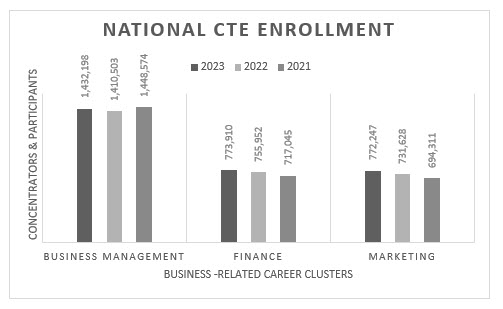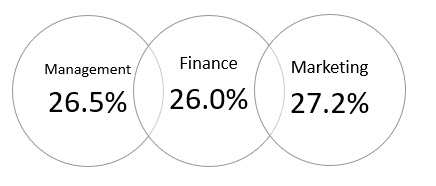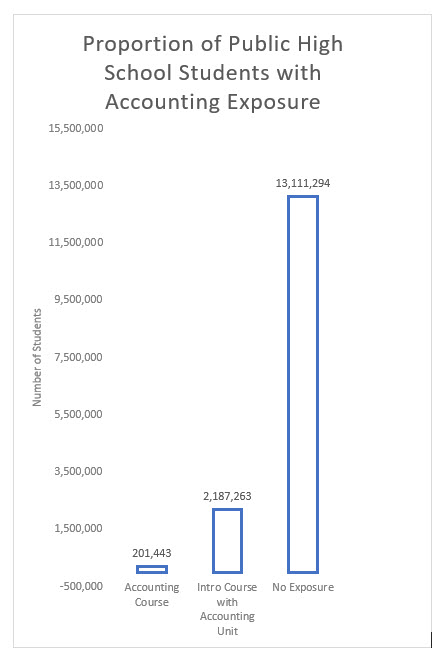Abstract: High school business educators are crucial in preparing students for future careers, but accounting—a key field—often receives limited attention in the curriculum. The 2023 National Pipeline Advisory Group (NPAG) report highlights a significant decline in students pursuing accounting degrees and sitting for the CPA exam. To address this, it’s essential to engage students with accounting concepts earlier in their education. This article explores ways to enhance the Introduction to Business and Marketing course by incorporating practical, real-world accounting applications and partnering with CPAs. By integrating case studies, interactive accounting software, and CPA guest speakers into lessons, teachers can offer students a more comprehensive understanding of accounting’s role in business and finance. Currently, fewer than 1.5% of U.S. high school students are enrolled in an accounting course, revealing a critical gap in the profession’s pipeline. Strengthening high school accounting education and collaboration with CPAs can help inspire students to consider accounting as a career path, addressing the profession’s growing workforce challenges.
Keywords: Accounting education, CPA engagement, high school curriculum, business teachers, career pipeline, workforce development
___________________________________________
High school business educators play an essential role in shaping the future workforce by providing students with foundational knowledge of business principles. One of the key opportunities within the Introduction to Business and Marketing course is exposing students to the world of accounting—a field that is crucial but often misunderstood by students. With a nationwide shortage of qualified accountants, as highlighted by the National Pipeline Advisory Group (NPAG) report, there is an urgent need to offer students more comprehensive early engagement with accounting (AICPA, 2023).
The NPAG report stresses that fewer students are pursuing accounting degrees or sitting for the CPA exam. To address this gap, it is important to engage students at an earlier stage in their education (AICPA, 2023). High school courses like Introduction to Business and Marketing provide an ideal entry point for introducing students to accounting concepts, laying the groundwork for future career choices.
Introduction to CTE Career Cluster Enrollment
The data in Figure 1 illustrates the national enrollment of students in business-related Career and Technical Education (CTE) clusters, specifically highlighting the Business Management, Finance, and Marketing clusters from 2021 to 2023. It is important to note that these numbers reflect both concentrators and participants, as classified in the Perkins data.

A participant is defined as a student who has completed at least one course in a CTE program area, while a concentrator is a student who has completed a defined sequence of courses or achieved a specific level of credit in the program, indicating deeper involvement. These classifications can sometimes lead to overlapping numbers, as students may concentrate or participate in more than one CTE cluster, which may result in potential double-counting in the data. Despite this, the enrollment numbers provide valuable insights into the scale and reach of business-related education within the CTE system.
Discussion of the Data
All three of these career clusters require students to complete the Introduction to Business and Marketing course as participants during their foundational training. This course serves as an essential gateway for students as they explore business-related careers, including accounting, which falls within the Finance Career Cluster. Given the consistent enrollment across these clusters, the Introduction to Business and Marketing course plays a crucial role in shaping students' early understanding of business principles and career pathways.
Introduction to Student Concentration in Business-Related Career Clusters
In Figure 2, the data illustrates the proportion of students in the Business Management, Finance, and Marketing clusters who are classified as concentrators in 2023. A concentrator refers to a student who has completed a defined sequence of courses, meaning they have progressed beyond the introductory level in their CTE pathway. The remainder of the students, nearly 75%, are classified as participants, which means they have only completed the initial course, Introduction to Business and Marketing.
Proportion of Enrolled Students Classified as Concentrators

In 2023, slightly more than one-quarter of students in these clusters were classified as concentrators. Specifically, there were 201,443 concentrators in the career fields that fall under the Finance cluster, which includes accounting. This means that across the entire nation, only 201,443 students were likely enrolled in an accounting course in that year.
To put this into perspective, the total number of public high school students in the United States is close to 50 million. This figure highlights a critical gap in the pipeline for future accountants and other finance professionals, underscoring the importance of ensuring that more students move beyond the introductory courses and into advanced coursework in these fields.
Figure 3 demonstrates that in 2023 only 1.3% (201,443 students) of the total 15.5 million public high school students in the U.S. were likely enrolled in an accounting course. Due to duplicate reporting between career clusters, the data doesn’t reveal the total enrollment in the Introduction to Business and Marketing course; however, between 2.9% (1,052,666 business management participants) and 14.1% (2,187,263 total participants across three business-related clusters) were likely enrolled in Introduction to Business and Marketing in 2023. This portion of students represents those who are receiving at least some exposure to business-related subjects, but it’s important to emphasize that even within this course, students generally receive only a brief introduction to accounting, often limited to a single unit. The remaining 83% of high school students had little to no exposure to the foundational principles of accounting, contributing to the ongoing challenges in the accounting pipeline.

Partnering with CPAs, who bring real-world experience and insights, offers a way to strengthen the accounting unit within this course and ensure students receive a well-rounded understanding of the profession.
The NPAG Report: Engaging Students Earlier
The NPAG report reveals that between 2019 and 2023, the accounting profession experienced a 17.3% reduction in its workforce, while the working-age population grew by just 3% (AICPA, 2023). Additionally, fewer students are enrolling in accounting programs and taking the CPA exam. This shrinking pipeline is a key concern for the future of the profession.
The report underscores the importance of engaging students at an earlier stage in their academic journey. Most high school students are not fully aware of the range of opportunities within accounting, and they may have a limited understanding of what accountants do. Enhancing the accounting curriculum in high school business courses offers a valuable opportunity to fill this gap.
Enhancing the Current Curriculum
The Introduction to Business and Marketing course provides a foundational overview of various business concepts, including accounting. However, there is potential to expand this unit to better engage students and provide more practical, real-world applications of accounting concepts. The following table outlines key areas for curriculum enhancement and suggests ways to incorporate CPA expertise to deepen student understanding.
|
Current Curriculum
|
Suggested Improvement
|
CPA Engagement and Targeted Exposure
|
|
Foundational Financial Concepts
|
Shift focus to introduce financial statements and using data over its preparation. Emphasize the dynamic role of accountants in solving real-world problems, emphasizing the societal impact of ethics, sustainability, and fraud prevention. Incorporate industries like sports, entertainment, and tech into lessons.
|
CPAs can share case studies from diverse fields—such as environmental accounting, forensic accounting, or technology startups—where financial decision-making and reporting have a significant impact (AICPA, n.d.).
|
|
Differentiating Fixed and Variable Expenses
|
Make cost analysis more relevant by highlighting exciting industries such as eSports, fashion, or sustainable energy. Showcase how accountants advise companies on cost-saving strategies and profitability analysis.
|
CPAs can bring real-life examples of how their firms help businesses become more profitable by optimizing fixed and variable expenses. Examples from cutting-edge fields will make accounting seem more impactful and innovative.
|
|
Preparing Mock Financial Documents
|
Add an element of excitement by incorporating forensic accounting challenges or investigating high-profile fraud cases. Create scenarios where students "uncover" financial discrepancies and present their findings.
|
CPAs can introduce students to the field of forensic accounting, including stories of major fraud investigations and how accountants play a critical role in uncovering and preventing financial crimes (Perkins Collaborative Resource Network, 2023).
|
|
Budget Planning for a CTSO Event or Project
|
Introduce the idea of accountants as strategic planners in areas like disaster recovery, sustainability, or global business expansion. Students could work on budgets for simulated crises or international operations.
|
CPAs can mentor students in strategic financial planning exercises, such as forecasting the budget for a tech startup or an international expansion, showing how accountants are key players in making businesses resilient and future-ready (AICPA, 2023).
|
Building Stronger Partnerships Between Educators and CPAs
High school business educators have deep expertise in teaching broad business principles, and CPAs bring complementary skills that can enhance students' learning experiences. By working together, business teachers and CPAs can provide students with a fuller understanding of the role accounting plays in various industries and personal finance.
Collaboration between educators and CPAs could involve sharing case studies, developing interactive lessons, and offering guest lectures. CPAs can offer valuable insights into real-world applications of accounting, helping students connect what they learn in the classroom to viable career paths.
National Programs and Resources
Several national programs support educators in introducing students to the accounting profession in an engaging way. For example, the AICPA’s Start Here, Go Places program offers interactive tools and resources designed to introduce students to accounting careers (AICPA, n.d.). The Accounting Pilot & Bridge Project (APBP) also helps teachers deepen their students' exposure to accounting by offering advanced training and materials for high school educators.
Incorporating resources like these into high school business courses aligns with the NPAG report’s recommendation to expose students to accounting earlier. This approach ensures students receive a comprehensive introduction to accounting and its various career opportunities.
Conclusion
High school business courses offer an invaluable opportunity to introduce students to the accounting profession. By enhancing the accounting unit in the Introduction to Business and Marketing course and partnering with CPAs, students can gain a clearer understanding of the field and its relevance to business and finance.
Through curriculum improvements and increased collaboration with accounting professionals, students will be better equipped to pursue accounting as a career, helping to build a stronger, more sustainable pipeline of future accountants. This partnership between educators and CPAs will not only address the profession's current workforce challenges but will also inspire students to explore the diverse opportunities that accounting offers.
References
AICPA. (n.d.). Start Here, Go Places. Retrieved from https://www.startheregoplaces.com
AICPA. (2023). National Pipeline Advisory Group (NPAG) report. American Institute of Certified Public Accountants.
Career and Technical Education (CTE) System. (n.d.). Introduction to Business and Marketing course curriculum. Retrieved from https://www.cte.gov
National Business Education Association (NBEA). (n.d.). NBEA annual meeting. Retrieved from https://www.nbea.org
National Center for Education Statistics. (2023). Public school enrollment. Retrieved from https://nces.ed.gov/programs/digest/d21/tables/dt21_203.10.asp
Perkins Collaborative Resource Network. (2023). Perkins V: Strengthening career and technical education for the 21st century act. U.S. Department of Education. Retrieved from https://cte.ed.gov
 Immediate Past President
Immediate Past President 2025-2026 President
2025-2026 President President-elect
President-elect